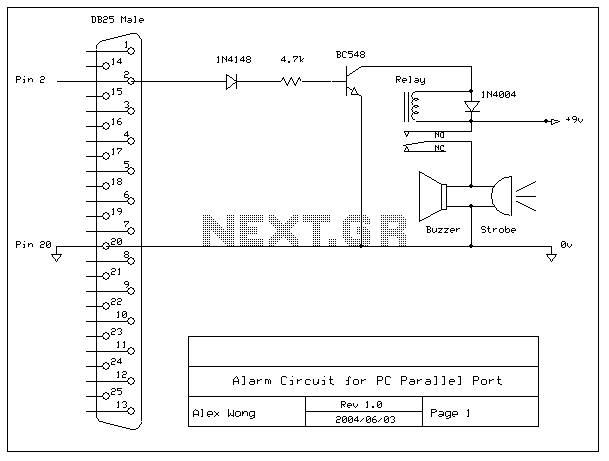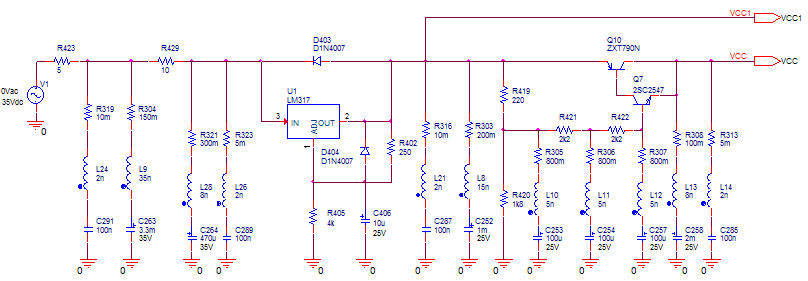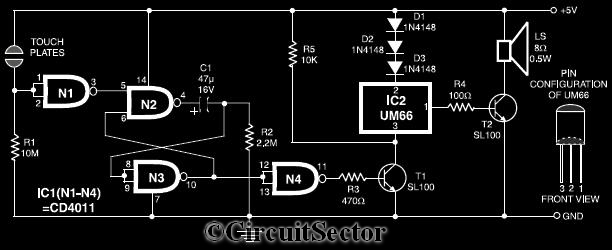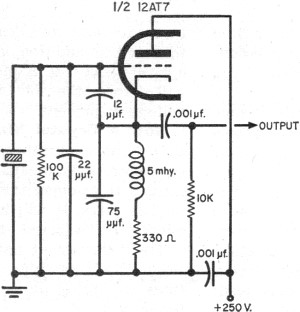
Schematics USB Sound Card with PCM2702 PCB
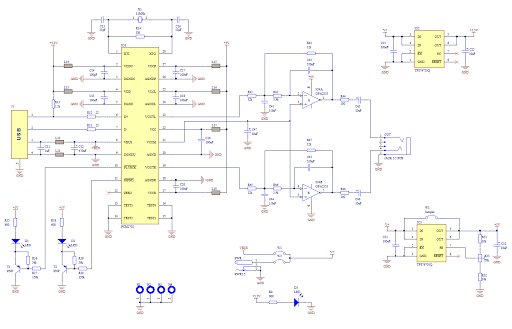
Creating a sound card is no longer a complex task. By utilizing the PCM2702 integrated circuit from Burr Brown / Texas Instruments, it is possible to design a fully functional USB sound card. This sound card can be powered directly from a USB port and features a single stereo output. No driver installation is required for Windows XP and Vista, as they are pre-installed, making it truly plug-and-play. The PCM2702 requires only a few additional components to operate. The schematic is straightforward. The sound card can be powered either from the USB port (jumper W1) or from an external power supply (jumper W3). The PCM2702 necessitates two power supplies: 3.3V (3V-3.6V) and 5V (4.5V-5.5V). A fixed output voltage low-dropout (LDO) regulator, TPS76733Q, is used for the 3.3V supply (IO2), while an adjustable output voltage LDO, TPS76701Q, is employed for the 5V supply (IO3). Both LDOs are manufactured by Texas Instruments. The output voltage of IO3 should be set slightly lower than the input voltage to ensure good stabilization of the LDO; in this case, the output voltage is set to 4.8V, adjustable via resistor R33. In scenarios with low power supply, IO3 can be bypassed by jumper W3. An LED (D3) indicates when power is on. Small ferrite beads are installed before all power pins of the PCM2702, as well as on the Vbus and GND of the USB connection, to reduce high-frequency noise. Although sourcing these small SMD ferrite beads may be challenging, they can be replaced with zero-ohm resistors if necessary. A low-pass filter is integrated into the output signal path to minimize sampling frequency artifacts. The OPA2353UA dual op-amp is configured as a stereo 2nd-order low-pass filter. Additionally, LED D1 lights up when the PCM2702 is playing audio data received from the USB bus, while LED D2 illuminates when the USB bus suspends audio data transmission to the PCM2702.
The circuit design for the USB sound card centered around the PCM2702 IC is efficient and user-friendly. The PCM2702 serves as the primary digital-to-analog converter (DAC), converting digital audio signals from the USB interface into analog signals suitable for output through the stereo jack. The choice of power supplies is critical, as the device requires both a 3.3V and a 5V supply to operate optimally. The TPS76733Q and TPS76701Q LDOs are selected for their reliability and performance characteristics, ensuring stable voltage outputs that are essential for audio fidelity.
The implementation of ferrite beads is a common practice in audio circuits to suppress electromagnetic interference. Their placement before the power pins of the PCM2702 and along the USB power lines helps to mitigate high-frequency noise that could adversely affect audio quality. The option to substitute these beads with zero-ohm resistors provides flexibility in the design, allowing for adjustments based on component availability.
The low-pass filter, utilizing the OPA2353UA op-amp, is a crucial component in managing the audio output. By configuring the op-amp in a 2nd-order low-pass filter arrangement, it effectively attenuates high-frequency noise and smooths the audio signal, thereby enhancing the listening experience. The filter design may include various resistor and capacitor values to tailor the cutoff frequency to the specific audio application.
LED indicators provide visual feedback on the operational status of the sound card. The power indicator (D3) ensures users are aware of power availability, while the audio activity indicators (D1 and D2) inform users of the data transmission status, adding an additional layer of usability to the design. Overall, the schematic for this USB sound card is straightforward yet effective, making it an excellent project for those interested in audio electronics.Make a sound card is no more a complex issue. If you use great IC PCM2702 from BURR BROWN / Texas Instruments you can create a fully functional USB sound card. This sound card can be powered from USB port and has one stereo output. You don ½t need to install any driver for Windows XP and Vista, because they are already inside. This is really plug and play. PCM2702 needs only few additional parts to work. The schematic is not complex. Sound card can be powered directly from USB port (jumper W1) or from external power supply (jumper W3). PCM2702 needs two power supply 3. 3V (3V-3. 6V) and 5V (4. 5V-5. 5V). I used fixed output voltage LDO TPS76733Q for 3. 3V (IO2) and adjustable output voltage LDO TPS76701Q for 5V (IO3). Both LDO are produced by TI, I used this because I had it in my drawer. Any similar LDO can be used. Output voltage of IO3 should be set to little bit lower than input voltage to allow LDO good stabilization, in my case output voltage is set to 4.
8V. Output voltage can be set by adjustable resistor R33. In case of low power supply, IO3 can be shorted by jumper W3. LED D3 signalizes power on. Small ferrite beads are placed before all power pins of PCM2702 and in Vbus and GND of USB. These small beads reduce high frequency hum. I had a problem find this small SMD ferrite beads in local stores but finally I acquire few of them from old hard drive. They are not absolutely necessary, you can use zero ohm resistors instead of them. Low-pass filter is placed in output signal path to reduce sampling frequency. An OPA2353UA dual op amp is configured as a stereo 2nd-order low-pass filter. Led diode D1 is illuminated when PCM2702 plays audio data received from the USB bus. Led diode D2 is illuminated when USB bus suspends audio data transmission to the PCM2702. 🔗 External reference
The circuit design for the USB sound card centered around the PCM2702 IC is efficient and user-friendly. The PCM2702 serves as the primary digital-to-analog converter (DAC), converting digital audio signals from the USB interface into analog signals suitable for output through the stereo jack. The choice of power supplies is critical, as the device requires both a 3.3V and a 5V supply to operate optimally. The TPS76733Q and TPS76701Q LDOs are selected for their reliability and performance characteristics, ensuring stable voltage outputs that are essential for audio fidelity.
The implementation of ferrite beads is a common practice in audio circuits to suppress electromagnetic interference. Their placement before the power pins of the PCM2702 and along the USB power lines helps to mitigate high-frequency noise that could adversely affect audio quality. The option to substitute these beads with zero-ohm resistors provides flexibility in the design, allowing for adjustments based on component availability.
The low-pass filter, utilizing the OPA2353UA op-amp, is a crucial component in managing the audio output. By configuring the op-amp in a 2nd-order low-pass filter arrangement, it effectively attenuates high-frequency noise and smooths the audio signal, thereby enhancing the listening experience. The filter design may include various resistor and capacitor values to tailor the cutoff frequency to the specific audio application.
LED indicators provide visual feedback on the operational status of the sound card. The power indicator (D3) ensures users are aware of power availability, while the audio activity indicators (D1 and D2) inform users of the data transmission status, adding an additional layer of usability to the design. Overall, the schematic for this USB sound card is straightforward yet effective, making it an excellent project for those interested in audio electronics.Make a sound card is no more a complex issue. If you use great IC PCM2702 from BURR BROWN / Texas Instruments you can create a fully functional USB sound card. This sound card can be powered from USB port and has one stereo output. You don ½t need to install any driver for Windows XP and Vista, because they are already inside. This is really plug and play. PCM2702 needs only few additional parts to work. The schematic is not complex. Sound card can be powered directly from USB port (jumper W1) or from external power supply (jumper W3). PCM2702 needs two power supply 3. 3V (3V-3. 6V) and 5V (4. 5V-5. 5V). I used fixed output voltage LDO TPS76733Q for 3. 3V (IO2) and adjustable output voltage LDO TPS76701Q for 5V (IO3). Both LDO are produced by TI, I used this because I had it in my drawer. Any similar LDO can be used. Output voltage of IO3 should be set to little bit lower than input voltage to allow LDO good stabilization, in my case output voltage is set to 4.
8V. Output voltage can be set by adjustable resistor R33. In case of low power supply, IO3 can be shorted by jumper W3. LED D3 signalizes power on. Small ferrite beads are placed before all power pins of PCM2702 and in Vbus and GND of USB. These small beads reduce high frequency hum. I had a problem find this small SMD ferrite beads in local stores but finally I acquire few of them from old hard drive. They are not absolutely necessary, you can use zero ohm resistors instead of them. Low-pass filter is placed in output signal path to reduce sampling frequency. An OPA2353UA dual op amp is configured as a stereo 2nd-order low-pass filter. Led diode D1 is illuminated when PCM2702 plays audio data received from the USB bus. Led diode D2 is illuminated when USB bus suspends audio data transmission to the PCM2702. 🔗 External reference
